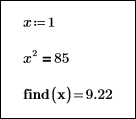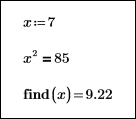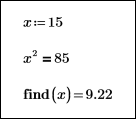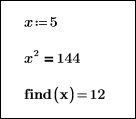About Guess Values
Guess values for all the unknown variables are required when you solve systems of linear or nonlinear equations, or when you optimize a function:
• For linear systems, guess values are only used to determine the size of the solution result; their values do not matter.
The solve blocks below show how the different guess values of x have no effect on the returned solution result:
 |
 |
 |
• For nonlinear problems, the solution is highly sensitive to guess values. The notes on choosing and modifying guess values for the root function apply.
Defining Guess Values
For find and minerr, you must define the unknown variables when you call the solve block function. The guess values must have the same name as the unknown variables.

For minimize and maximize, the unknown variables are clear since they are the arguments of the objective function (the function to optimize). You must, however, define a guess value for each of the unknown variables in the solve block function. The order in which you pass the guess values to minimize must be the same as the argument order for the objective function. Here, a is the guess value for θ and b is the guess value for φ:

Real or Complex Guess Values
Solve blocks first evaluate their constraints at the guess values to check for errors and to determine the solution domain.
If the guess values are real, and evaluation of the left-hand and right-hand sides of the constraints at the guess values produces only real values or matrices of real values, then a real solution is sought. Otherwise, the solver may return a complex solution.